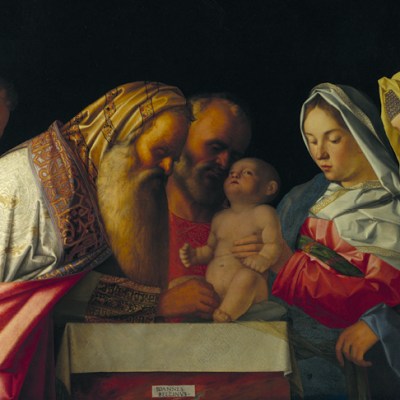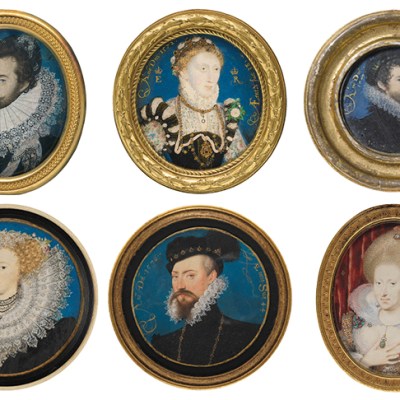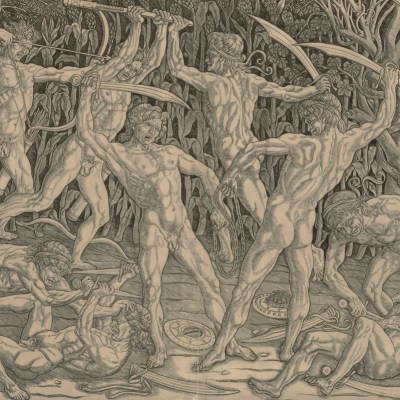For British art, 1619 was a year of deaths. The queen, Anne of Denmark, died in March, depriving artists in the country of one of their main patrons; this was bookended by the deaths of two of England’s most important painters, Nicholas Hilliard and William Larkin, in January and May. The arrival of Anthony van Dyck in London in 1621 marked a new cultural era in England, one increasingly open to the latest innovations from the continent. The court filled with budding connoisseurs, eager to purchase works of the great Renaissance painters. No sooner had Hilliard and Larkin died than they, and the tradition of Tudor and Jacobean portraiture they represented, were all but forgotten.
Anne, Countess of Pembroke (Lady Anne Clifford) (c. 1618), William Larkin. © National Portrait Gallery, London

Four hundred years on, there has been a renewal of interest in portraiture of the period. Particular attention has been given to Hilliard, along with the French-born Isaac Oliver, in the current exhibition ‘Elizabethan Treasures: Miniatures by Hilliard and Oliver’ at the National Portrait Gallery in London. Larkin, however, remains almost unknown. He has no exhibition, although a portrait by his hand, of Anne Clifford, is currently on show at Abbot Hall Art Gallery in Kendal as part of the NPG’s ‘Coming Home’ project (in which the gallery sent 50 portraits to places with which the sitters have a close affinity). And yet, Larkin was by far the most innovative painter of his time, reworking the Elizabethan portrait tradition into his own highly distinctive style.
The painting of Anne Clifford is one of Larkin’s smaller works, but it gives an insight into his extraordinary skill. The intricacy of the lace, and the minute detailing on the pattern of her dress, offer a beautiful demonstration of what Larkin did best: clothes. Sumptuous silks, jewel-encrusted heels, and outrageous feathers stand out on every one of his canvases. Records show that each of his subjects would sit for a painting a few times, and then send their clothes on after them, to be painted at length after the sittings. One can only imagine the high aristocracy of the Jacobean court picking out their most prized garments for their latest portrait.
Lady Diana Cecil (c. 1614–18), William Larkin. Kenwood, London (English Heritage). Image: Wikimedia Commons (public domain)

Today these paintings are a key source of information about early 17th-century fashion. Standing before Larkin’s enormous portrait of Lady Diana Cecil (one of the nine Larkin portraits at Kenwood House, known as the Suffolk Collection) it is easy to see why. Her silver silk dress is covered with minute gold patterning, every fleck recorded by the artist’s skilled hand. What made Larkin innovative was not the materials he used or the expressions of his sitters, but the precision of the way in which he applied his paint. Metallic leaf was never used, but triple-layers of brown, orange, and yellow for the depiction of gold, and dark grey, mid-grey and white for silver. The layers of paint literally raise the depicted details from the canvas; they catch the light, as though they were gems.
Also in the Suffolk Collection is Larkin’s portrait of Richard Sackville from 1613, with its extraordinarily delicate depiction of lace, hanging behind the sitter’s shapely calves. Sackville was Larkin’s great patron, and four of the painter’s works can still be seen hanging on the walls of Knole Park. But Larkin was doomed by association with intrigue, scandal, and even treachery: his sitters included the infamous Frances Howard, the roguish Edward Sackville, and the ill-fated Arabella Stuart. He won approval enough to paint the court favourite George Villiers, but it would seem that royal patronage eluded him.
Richard Sackville (1589–1624), 3rd Earl of Dorset (1613), William Larkin. Kenwood, London (English Heritage). Image: Wikimedia Commons (public domain)

After his death, in May 1619, Larkin disappeared from history. A near-mythical figure emerged in his place: ‘the Curtain Master’. Deep in the archives of the National Portrait Gallery was buried a file containing a number of reproductions of portraits all attributed to this elusive painter. What these pictures most readily had in common was the pose of the sitter – standing in slight profile, facing the viewer’s left – and, more significantly, the fact that they stood between two silk curtains, usually slightly drawn. It was only in the 1950s that Roy Strong (then a curator at the NPG) and James Lees-Milne began to put the pieces together. Many of the portraits (but not all) are now known to be works by Larkin. Today there are 42 works attributed to Larkin, housed in galleries and private collections all over the world, with the most extensive collection at Kenwood.
Larkin’s works are the most glorious example of the Tudor/Jacobean portrait, and they encapsulate both the pinnacle and the end of an era – although they also contain hints of what is soon to come. Already the faces show a little more character, and the symbolism associated with the subjects is far subtler, pointing towards an age of naturalism ushered in by the artists who followed; Van Dyck, Rubens, and both Orazio and Artemisia Gentileschi, were just some of the artists who would grace the English court over the next two decades.


